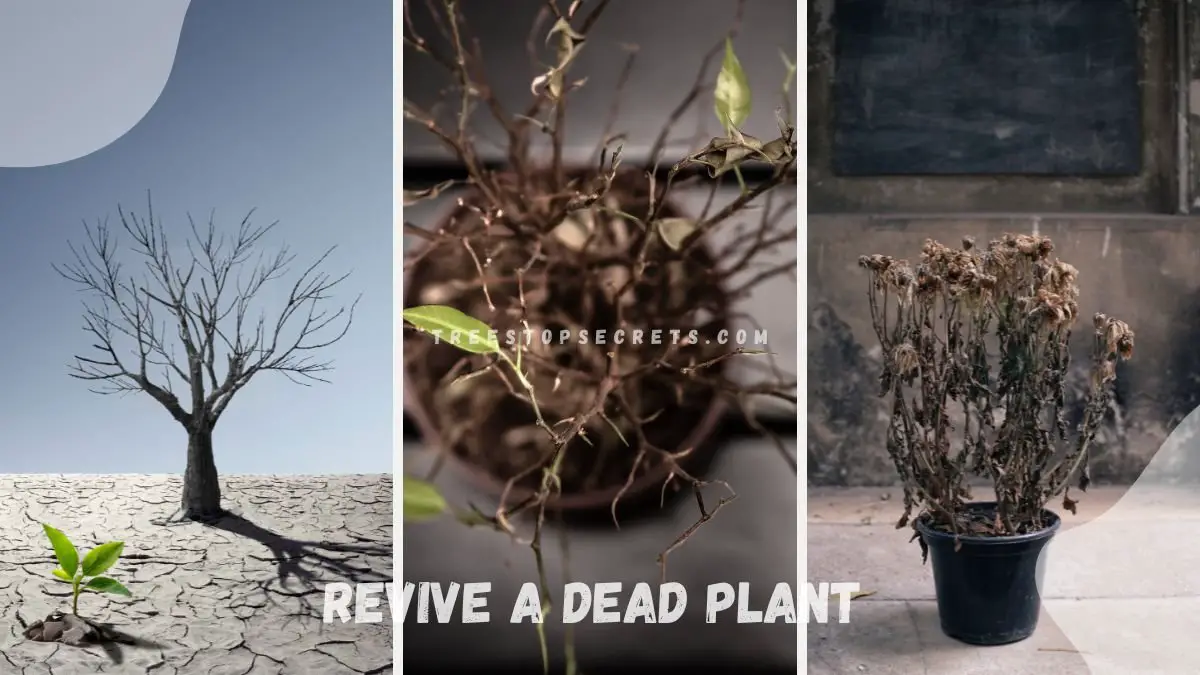Reviving a dead plant may seem daunting, but it’s often easier than it appears. Many plants with dead foliage and dead stems can be brought back to health with water, the right care, and attention. Whether you're dealing with overwatering, under watering, or pests, knowing how to revive a dead plant can make a significant difference. This guide will walk you through practical steps to identify the problem, address it, and help your plant thrive again. From examining the roots to adjusting watering routines, you’ll find simple yet effective methods to restore your plant's vitality.
To revive a dead plant, start by checking for signs of life such as green stems or roots. Trim away any dead parts to allow the plant to focus on new growth. Ensure that the plant is in suitable soil and receives the correct amount of light and water. Re-potting in fresh soil can often help if the roots are too cramped or rotting. For an added boost, consider using a diluted fertilizer. Be patient and monitor the plant's progress, adjusting care as needed to encourage recovery.
If you’re interested in learning more about specific indoor plant types, advanced care techniques, or troubleshooting persistent water issues, we have plenty of detailed guides and expert advice to help you succeed. Keep exploring to give your plants the best chance to flourish.
Key Takeaways
- Recognize Distress Signs: Pay attention to wilting, yellowing, or drooping leaves as early signs of plant distress in indoor plants.
- Initial Recovery Steps: Act promptly by adjusting watering, light exposure, and repotting if necessary to revive a struggling plant.
- Long-term Plant Care: Maintain consistent care by watering appropriately, providing adequate light, and fertilizing as needed for sustained plant health.
- Understanding Plant Needs: Learn about the specific requirements of your plant species to ensure proper care and growth.
- Revival Techniques: Implement techniques like pruning, repotting, or changing the soil mix to rejuvenate a dying plant.
- Recognizing Failure Signs: Be aware of persistent wilting, browning, or stunted growth as indications that your plant may not recover.
- Preventive Measures: Establish a regular care routine, monitor plant health regularly, and address issues promptly to prevent plants from reaching critical conditions.
Recognize Distress Signs
When reviving a dead plant, it's crucial to look for life indicators. Check the stem for any green, a clear sign of vitality. Examine the roots - plumpness and white to tan color indicate health. Focus on new growth and healthy roots as signs of life.
Look for Life
Check for any green on the stem as a sign of life. Examine the roots for plumpness and white to tan color. Focus on new growth and healthy roots to determine signs of life.
Assess Water Issues
Overwatering Symptoms
- Identify overwatering through yellowing leaves or root rot.
- Adjust watering frequency to prevent further damage.
- Ensure proper drainage to avoid waterlogged soil.
Underwatering Symptoms
- Recognize underwatering by dry, crispy leaves or wilting.
- Increase watering gradually to revive the plant.
- Monitor soil moisture levels regularly.
Check Lighting
Assess the current lighting conditions for adequacy. Consider moving the plant to a brighter location if needed. Avoid direct sunlight if the plant is sensitive to light.
Initial Recovery Steps
Remove Dead Leaves
When removing dead leaves, you allow space for new growth to emerge and flourish. Focus on pruning areas that show no signs of life, as they hinder the plant's recovery process. Keeping the plant clean is essential to prevent diseases from spreading.
Trim Stems
Trimming back stems to green tissue encourages rejuvenation in the plant. Always use sterilized tools to prevent infections from entering fresh wounds. Be sure to prune any damaged or decaying parts to promote overall health.
Adjust Lighting
To optimize growth, adjust the plant's position to ensure it receives adequate light exposure. Rotating the plant periodically promotes even growth across all sides. In cases of insufficient natural light, consider utilizing artificial lighting sources.
Improve Humidity
Increasing humidity levels is crucial for plants that thrive in such environments. Regularly misting the plant helps maintain adequate moisture levels for healthy growth. Grouping plants together can create a humid microclimate, benefiting those that require higher humidity levels.
Long-term Plant Care
Provide Nutrients
Supplement the plant with compost or fertilizer to boost its health. Follow recommended dosage to prevent nutrient burn. Opt for slow-release fertilizers for sustained nourishment.
Wait and Watch
Be patient and allow the plant time to recover naturally. Observe any changes in its health gradually over several weeks. Refrain from excessive interventions that may hinder the recovery process.
Prevent Decline
Watering Correctly
- Water the plant at its base to prevent fungal growth.
- Use room temperature water to avoid shocking the plant.
- Adjust watering frequency according to its specific needs.
Proper Lighting
- Ensure the plant receives adequate indirect sunlight for growth.
- Avoid placing it near drafty areas like windows or vents.
- Incorporate grow lights for plants requiring intense light exposure.
Understanding Plant Needs
Watering Needs
Plants have specific watering needs depending on their species. Different plants require varying amounts of water to thrive. Factors like humidity and temperature play a crucial role in determining how often you should water your plants. It's essential to use a well-draining potting mix to prevent waterlogging, which can lead to root rot and other issues.
Lighting Needs
Understanding the specific lighting requirements of your plants is vital for their growth. Providing sufficient light is crucial for photosynthesis, the process through which plants create energy. Some plants thrive in direct sunlight, while others prefer indirect light. Light-sensitive plants should be shielded from harsh, direct sunlight to prevent damage.
Humidity Levels
Maintaining optimal humidity levels is essential for the health of tropical plants. These plants typically thrive in humid environments and may suffer if exposed to dry air. Using a humidity tray or a room humidifier can help create the ideal moisture levels for moisture-loving plants. However, it's important to avoid misting plants that are prone to fungal diseases, as excess moisture can promote fungal growth.
Revival Techniques
Essential Nutrients
Plants require essential macronutrients like nitrogen, phosphorus, and potassium for growth. Micronutrients such as iron, magnesium, and calcium are vital for overall plant health. Monitor nutrient deficiencies by observing leaf discoloration or stunted growth.
- Pros: Ensures optimal plant growth and development.
- Cons: Overdosing nutrients can harm the plant.
Humidity Adjustment
Adjust humidity levels according to the specific needs of the plant. Utilize a humidity gauge to accurately measure the humidity levels in your home. Create a humid environment by clustering plants together.
- Key Information: Different plants have varying humidity requirements.
- Examples: Ferns thrive in high humidity, while cacti prefer low humidity.
Assessing Lighting
Evaluate the current lighting conditions surrounding the plant to ensure its well-being. Factors such as light duration and intensity play a crucial role in plant growth. Adapt the lighting based on how the plant responds and its growth patterns.
- Step 1: Observe how the plant reacts to its current lighting conditions.
- Step 2: Increase or decrease light exposure based on plant behavior.
Recognizing Failure Signs
Understanding Death Causes
Plants can die due to various reasons. Identify potential causes like overwatering, underwatering, or lack of sunlight. Address issues such as pest infestations or environmental changes promptly. Learn from past mistakes by keeping a plant journal to track care routines and identify patterns.
When to Compost
Composting a dead plant is an eco-friendly solution. Consider composting as a sustainable recycling option rather than throwing it away. Dispose of dead plants responsibly to benefit the environment by returning nutrients back to the soil. Use composted material to enrich the soil for other plants, promoting healthy growth.
Preventive Measures
Avoid Overwatering
Prevent overwatering by letting the soil dry out between waterings. This helps avoid root rot and fungal growth. Use pots with drainage holes to ensure excess water can escape, preventing waterlogged soil. Adjust your watering schedule based on the specific needs of your plants and the season.
Ensure Adequate Light
Ensure your plants get enough light for photosynthesis, which is crucial for their growth. Monitor their exposure to light to prevent issues like sunburn or light deficiency. Rotate your plants regularly to ensure they receive uniform light distribution and grow evenly.
Regular Trimming
Regularly trim any dead or yellowing leaves from your plants to maintain their overall health. By pruning overgrown stems, you can promote new growth and encourage a bushier appearance. Keeping your plants tidy by removing excess foliage also helps improve air circulation around them.
Closing Thoughts
After understanding the distress signs, initial recovery steps, long-term care, plant needs, revival techniques, failure signs, and preventive measures, you are now equipped to revive your dying plants successfully. Remember to be attentive to your plant's signals, provide consistent care, and adjust as needed. By recognizing the signs early on and taking proactive measures, you can ensure the health and vitality of your beloved green companions.
Now that you have the knowledge and tools to bring your plants back to life, take action today. Implement the strategies you've learned, observe your plants closely, and enjoy the rewarding experience of nurturing them back to health. Your commitment will not only revive your plants but also deepen your connection with nature. Happy gardening!
Frequently Asked Questions
How can I recognize distress signs in my plant?
To identify distress signs in your plant, look for wilting leaves, yellowing or browning of foliage, stunted growth, and unusual spots or discoloration on the leaves. These signs indicate that your plant is not in optimal health.
What are the initial recovery steps for a dying plant?
The initial recovery steps for a dying plant include assessing its watering and lighting needs, checking for root rot, repotting if necessary, and trimming away any dead or damaged parts. Providing proper care based on the plant's specific requirements is crucial.
How do I understand my plant's needs for effective care?
Understanding your plant's needs involves researching its species to determine its ideal light, water, humidity, and temperature requirements. Observing your plant regularly and adjusting care practices accordingly will help you provide the best environment for its growth and health.
What are some effective revival techniques for a struggling plant?
Effective revival techniques include adjusting watering frequency, improving drainage, providing adequate sunlight, fertilizing appropriately, and addressing any pest infestations promptly. Tailoring your approach based on the plant's condition will increase its chances of recovery.
What preventive measures can I take to avoid my plants from dying?
To prevent plants from dying, ensure you follow a consistent watering schedule, monitor light exposure, maintain proper humidity levels, avoid over-fertilizing, inspect for pests regularly, and repot when needed. By proactively caring for your plants, you can help them thrive and avoid common issues leading to their decline.
Image Source: Paid image from CANVA



